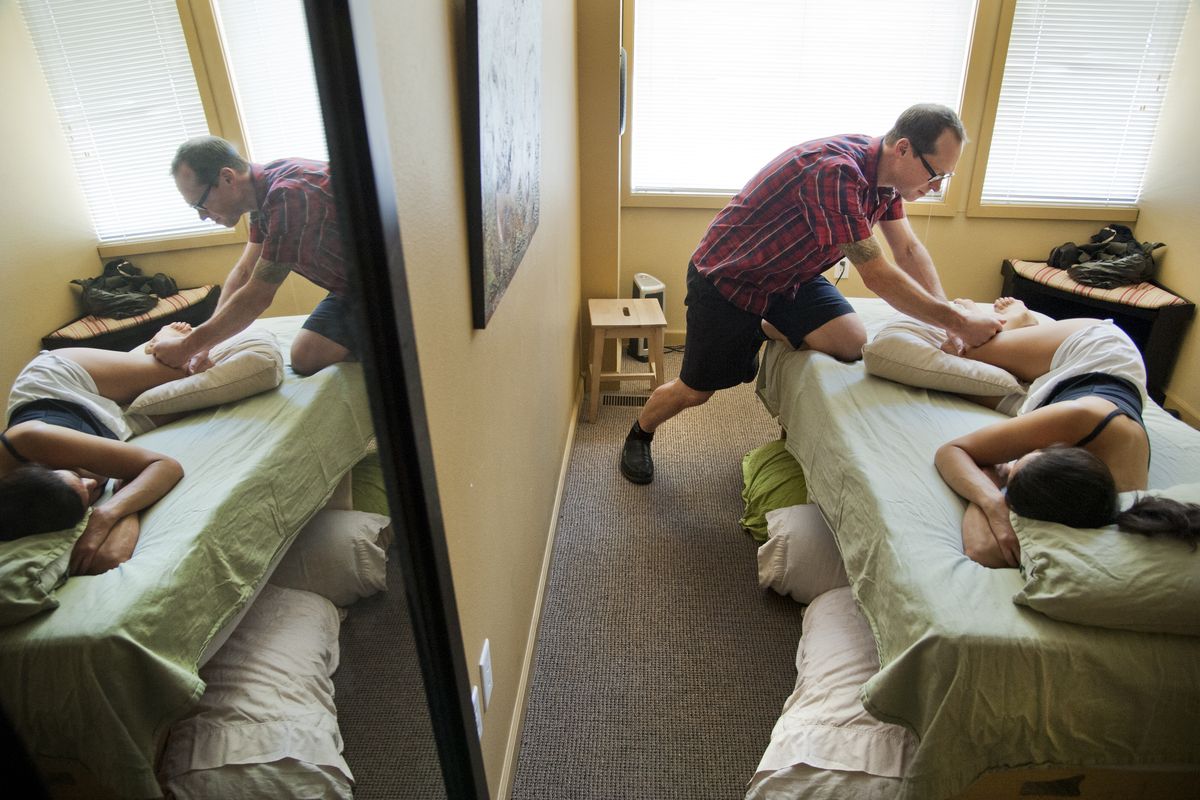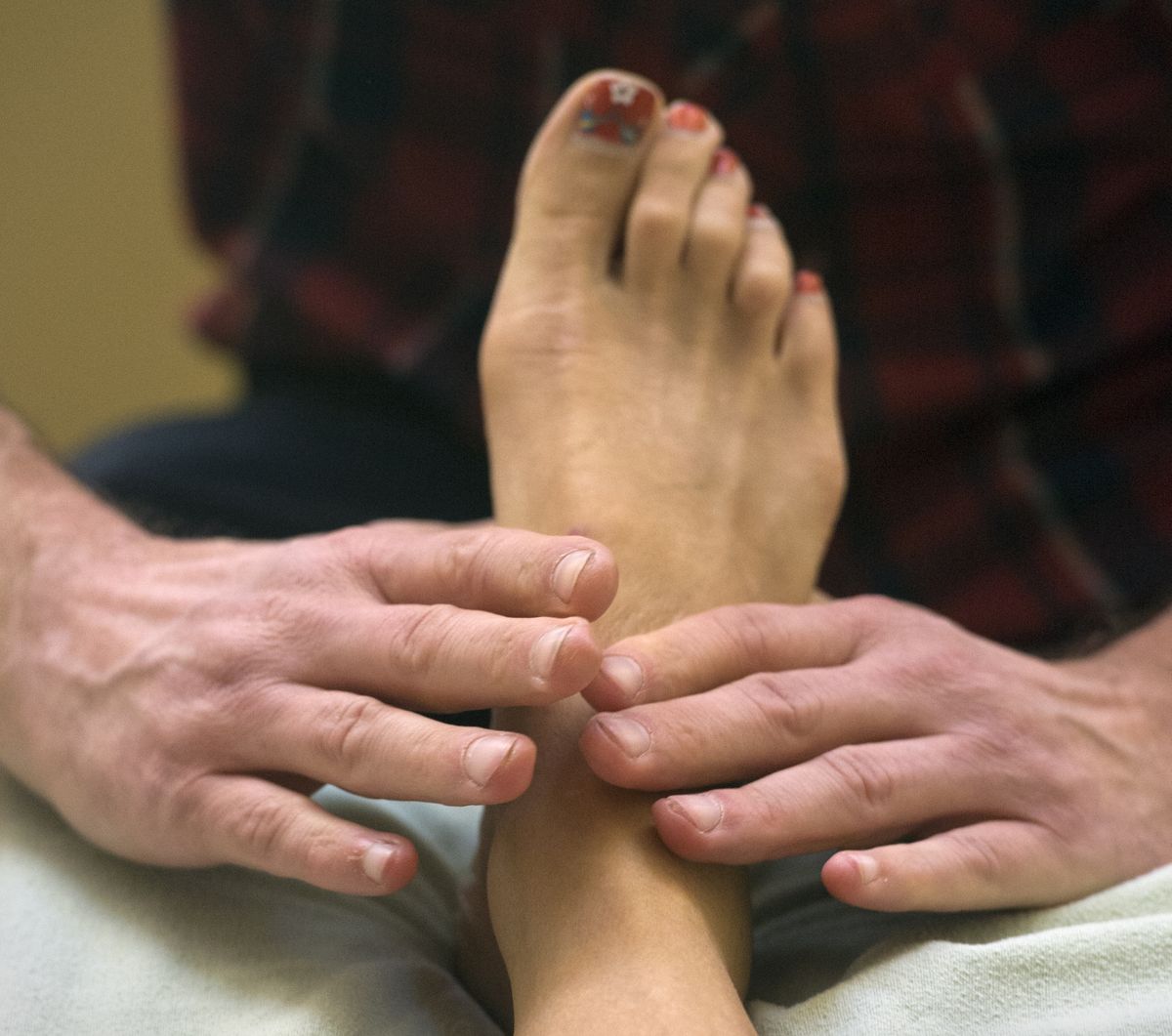Speak to doctor when choosing complementary medical provider
Jake McBurns conducts a Rolfing session with his patient, Melissa Cole, in downtown Spokane. Rolfing is a form of “structural integration,” a line of complementary medicine that uses touch to balance the body and align it with gravity. (Dan Pelle)Buy a print of this photo
With his clients standing or resting on a table or bench in his downtown Spokane office, he uses his knuckles, hands and elbows to manipulate their connective tissues, or fascia.
McBurns said he sees himself as part of clients’ larger team of practitioners, including doctors and other complementary providers. They find him mostly through referrals from friends and co-workers or from doctors, he said, who might say. “ ‘Oh, go see Jake, he does some voodoo.’ ”
What’s viewed as “voodoo” and what’s considered mainstream evolves in the world of complementary health care. Massage is now used in some hospitals. Physicians are taking classes in acupuncture.
Meanwhile, new and old alternative options ebb and flow in popularity, word of their virtues spread by word of mouth, media reports and TV shows.
How to choose? When considering a form of complementary medicine, experts advise, ask a lot of questions and consider your sources.
Nearly 40 percent of Americans use health care approaches that fall outside mainstream Western medicine, according to the National Center for Complementary and Alternative Medicine, part of the National Institutes of Health.
That includes complementary and alternative techniques, either “mind and body” practices (such movement therapies or spinal manipulation) or natural products (such as herbs, vitamins and minerals).
Complementary refers to non-mainstream medicine used together with Western medicine. Alternative medicine is used in place of Western medicine. True alternative medicine is rare, according to the national center.
It can be hard to get a handle on the vast options offered under the banner of complementary or alternative medicine, said Dr. Zorba Paster, the family physician and public-radio host who visited Spokane last week to deliver a fundraising talk for KPBX.
The loose label includes “charlatans” along with legitimate providers, Paster said.
One way to check out a practitioner is to look up their credentials with the state. There’s no national system of oversight for complementary health care providers.
But even within a state, the degree of regulation varies widely, depending on the kind of provider – leaving it to consumers to study up on complementary treatments and practitioners’ credentials.
Cancer Care Northwest offers some complementary care – nutrition services, mental health counseling and yoga – along with conventional cancer care. It also sends patients to see acupuncturists, naturopaths and physical therapists.
“We are totally systems people,” said Bobbi Hamilton, manager of the center’s oncology counseling program.
But the first thing she tells patients considering complementary care is to talk with their doctors first. One reason: Some therapies can counter- act the effects of medical treatment.
She also urges patients to use non-mainstream techniques alongside their conventional treatments, not instead of them.
And when it comes to researching a complementary treatment or practitioner, “I use everything at my disposal,” Hamilton said.
When looking online, she said, consult research-based websites, such as those run by the federal government or the Mayo Clinic.
When checking on credentials, seek out information not only on whether they were trained, but where. Then investigate the school where they trained – make sure it’s not a “fly-by-night place,” she said.
Make sure the practitioner isn’t operating outside his or her area of expertise, and check online reviews left by previous clients.
State credentials also can indicate a practitioner’s level of training – and raise a flag when someone’s filed a complaint against them.
Washington and Idaho regulate acupuncturists, massage therapists and other complementary providers along with physicians and surgeons, officially credentialing those who meet state requirements.
Washington, in fact, regulates more categories of health care providers than any other state, said Blake Maresh, an executive director in the Department of Health’s Office of Health Professions and Facilities.
The degree of regulation varies, depending on the complexity of the treatment. Those offering complex forms of practice require licenses and must meet the state’s educational and training requirements.
Providers offering treatments considered the least complex fall under registration requirements, Maresh said, with “certification” falling in between.
Acupuncturists need licenses. Hypnotherapists, on the other hand, get their state credentials by registering – providing the state their names and addresses. And while licensing is required for practitioners offering those more complex treatments, registration is optional.
But providers’ specialties – Rolfing, for example – aren’t necessarily reflected in their state credentials. McBurns is a licensed massage practitioner. But Rolf is not massage, he said, and his professional certification in the Rolf Method comes from a private organization, the Guild for Structural Integration.
In addition, the state doesn’t oversee every category of alternative treatment. One notable exception, Maresh said: homeopathy, the use of substances from plants, minerals or animals in an attempt to cure diseases based on beliefs that “like cures like” and that lower doses of medication are more effective.
Gretchen Cunningham, a Spokane craniosacral therapist, uses gentle touch, usually of the head, to “free up” parts of the body that aren’t moving as they should. She said she learned the technique after it helped her recover from a 2003 car accident.
Cunningham, licensed as a massage therapist, advised asking trusted friends and family to recommend providers. Most of Cunningham’s clients find her by word of mouth.
She tells clients they’re free to ask questions while she works.
“Not every practitioner is a good match for everybody,” she said. “… I tell people by two sessions, they’ll really know if what I do is going to make a difference for them.”
Melissa Cole, 47, visited McBurns last week. The Spokane Valley resident is an artist; her work can have her hunched over a desk or lifting heavy objects.
She learned about Rolfing from a relative who’d visited a practitioner for years. Looking for a way to address some hip and joint problems, she checked out the Guild for Structural Integration’s website and got recommendations from other people before contacting McBurns about three years ago.
“I go in to become more stable,” Cole said. “He’ll work on your ankles, your knees, your hips. I feel like I’m standing much straighter.”

